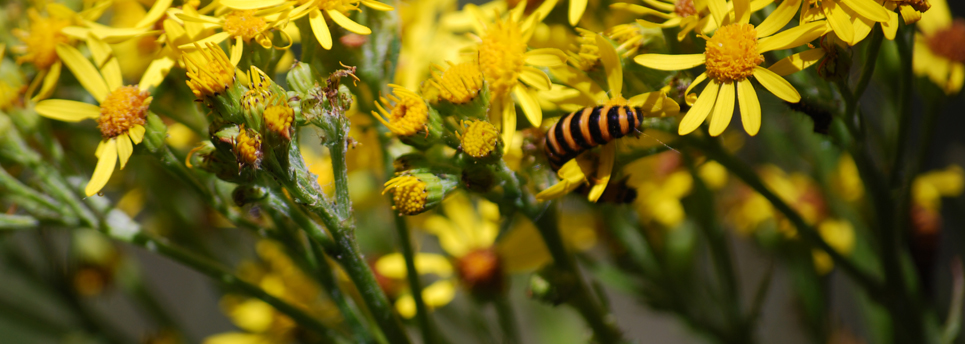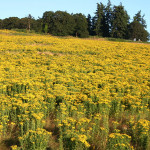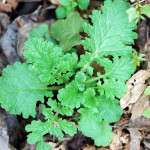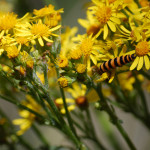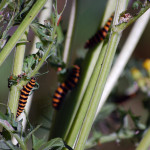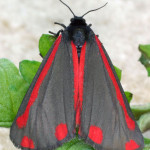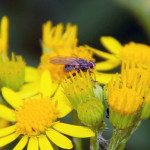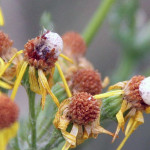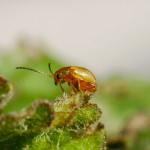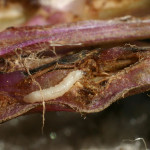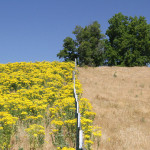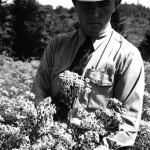Common name:
Tansy Ragwort, Stinking Willie, Staggerwort, Tansy butterweed
Scientific Name:
Senecio jacobaea (syn. Jacobaea vulgaris)
Noxious Weed Listing:
Description:
General:
Tansy ragwort is a tall biennial plant in the sunflower family. It can grow up to 6 feet in height at maturity. The rigid stems of tansy ragwort are green with an occasional reddish tinge. Plants typically arise from a single stem that becomes branched at the top of the plant, forming flat clusters of bright yellow flowers. The yellow daisy-like flowers have dark yellow to orange centers. Leaves are dark green and ruffled in appearance. Tansy ragwort grows as a rosette in its first year before transitioning into the mature flowering form in its second year of growth. Tansy ragwort can form dense patches, particularly on disturbed sites. This noxious weed is dangerous to humans and livestock due to a poisonous alkaloid (hepatotoxic pyrrolizidine) in its tissue which causes liver damage when ingested.
Leaves:
Tansy ragwort leaves are evenly spaced and alternate along the stem. Leaves decrease in size toward the top of the plant. Leaves can be smooth, or lightly hairy on their underside of lower leaves. Leaves are dark green and generally lighter on the underside. The leaves of Tansy ragwort are pinnate and appear to be ruffled in appearance.
Flowers
Tansy ragwort has bright yellow, showy flowers forming a flat-topped cluster at the end of the stem. There can be anywhere from 20 to 60 flowers in a cluster. The daisy-like flowers have numerous disc flowers surrounded by 10-15 evenly spaced ray flowers. Peak flowering occurs from July to September.
Fruits
Tansy ragwort produces very small, cylindrical seed like fruits called achenes. The achenes from the ray flowers are smooth while the achenes from the disc flowers are hairy. The achenes have a dandelion-like set of bristly hairs called a pappus which aids in dispersal of the seed by the wind. Adult plants can produce up to 200,000 seeds. Seeds can remain viable in the soil for more than 10 years.
Roots
The root system of tansy ragwort consists of a distinct taproot or crown with lateral and secondary roots spreading away from the plant. Roots can reach 1 foot deep into the soil. New root shoots are easily formed if a plant is mowed, cut, or injured.
Reproduction:
Tansy ragwort reproduces predominantly by seed, but in some instances can also spread vegetatively. Seeds are dispersed by wind or by wildlife. Seeds can also be transported by machinery, contaminated soil and hay, and boots and clothing.and by seed. Vegetative reproduction occurs when roots or the crown are injured and new shoots develop. The fragments from the injured roots can generate new shoots.
Habitat:
Tansy ragwort is opportunistic plant often found in disturbed areas. Tansy ragwort likes a cool and wet climate, well-drained soils and full to partial sun. Patches are found in pastures, fields, grasslands, vacant land, waste places, horse trails, roadsides, rangeland, riparian areas, forested areas, and clear cuts. Areas of greatest concern are improperly managed pastures and disturbed areas.
Impacts:
- Competes with and displaces native vegetation.
- Contains alkaloids that are lethal to most livestock, with death occurring after consuming 3-8% of body weight (Boersma et al. 2006).
- Can contaminate hay, milk, and honey.
- Reduces pasture productivity.
Introduction:
Native to Eurasia, tansy ragwort was first reported in the United States in California in 1912. In Oregon, tansy ragwort was believed to have been introduced through contaminated ballast in the early 1900s (Christy et al., 2009). The first documented herbaria record for tansy ragwort is from Multnomah county in 1922. Since becoming established it has spread across western Oregon.
Distribution:
Clackamas County:
Tansy ragwort can be found throughout Clackamas County. It is very widespread and directly impacts properties throughout the county. As a ubiquitous weed, this is not a species that is actively surveyed. Mapped distributions do not represent the full extent of the tansy ragwort population in Clackamas County.
State of Oregon:
United States:
Management:
Strategy:
The management of invasive weeds is best served through a process known as Integrated Pest Management (IPM). IPM is a weed management methodology that utilizes:
- Management thresholds to determine when and if to initiate control,
- The ecology and life history characteristics of the targeted invasive weed,
- Site-specific conditions and land use considerations to inform management practices,
- The effectiveness and efficiency of various control methods.
An IPM based strategy ensures the maximum effectiveness of treatment measures. IPM strategies typically use more than one management method to target one or more susceptible life stages. It is adaptive to site conditions in the field and to the response of a plant to management. The utilization of multiple management tools also inherently reduces the use of herbicides in a management plan. The IPM process ultimately provides a framework for the establishment of Best Management Practices (BMP) which outlines the best approach for controlling a particular weed infestation.
Manual:
Tansy ragwort can be effectively controlled by biological, chemical, and manual methods. It is an important plant to control, especially in hay and pasture lands, where it can harm grazing animals. As with any control method, it is important to avoid disturbing the soil as much as possible. Soil disturbance can bring buried seeds to the surface, and lead to increased soil erosion. Due to the toxicity of tansy ragwort, be sure to wear gloves and protective clothing when removing this plant.
Tansy ragwort can be controlled by digging or pulling. Plants should ideally be pulled between May and June, after they bolt and before they flower. Pulling and digging is easier when the soil is moist. Later in the season, soils dry and harden making tansy ragwort plants much more difficult to remove. Rosettes should be dug up, removing as much as the root as possible. Grubbing tools, hoes, and shovels can be used.
Mechanical:
Mowing is not a suggested means of control for tansy ragwort. While mowing may prevent the plant from immediately producing seeds, it also stimulates additional vegetative growth. This leads to more plants and more stems per plant in the same season. Mowing is especially problematic in pastures, where it can spread the toxic leaves making it harder for grazing animals to avoid.
Cultural:
Grazing of Tansy ragwort is generally discouraged. For most grazing animals, the plant is highly toxic. Sheep are known to tolerate the alkaloids, but tansy ragwort is not considered desirable forage. The impacts of grazing on tansy ragwort is similar to mowing, and may help to suppress the plant, but is not an effective control method.
Chemical:
Herbicide application is an effective means to control tansy ragwort infestations. Tansy ragwort is susceptible to several systemic herbicides. Be cautious when using herbicides on pasture land with grazing animals.
Before you Start:
- Before purchasing any herbicide product it is important to read the label. The label is the Law. Carefully review all parts of the label even if you have used the product before. Select a product that is most appropriate for your site. If you have questions, ask your vendor before purchasing a product.
- When selecting herbicides always use a product appropriately labeled for your site. Follow label recommendations and restrictions at all times. If any information provided here contradicts the label, the label takes precedence. Always follow the label!
- Protect yourself. Always wear the recommended protective clothing identified on your label.
- When applying herbicides use spot spray techniques whenever possible to avoid harming non-target plants.
- Do not apply during windy or breezy conditions that may result in drift to non-target plants
- Avoid spraying near water. Hand-pull in these areas, to protect aquatic and riparian plants and wildlife.
- Avoid exposure to pets, pollinators, and wildlife. Remove animals from treatment areas to avoid exposure to herbicides. Follow the reentry instructions on your herbicide label and keep pets out of the area until the herbicides have dried.
- Avoid spraying blooming plants to minimize any effects to bees and pollinators, and makes applications at times of the day when insects and animals are not active.
- Be sure to store any chemicals, out of the reach of children and pets to keep your family safe.
- Product labels and formulations change regularly. Check the Pacific Northwest Weed Management Handbook and the product label for current control recommendations.
Herbicides:
The mention of any brand name product is not, and should not be construed as an endorsement for that product. They are included here only for educational purposes. Suggested rates are generalized by active ingredient. Specific rates will vary between products. Be sure to review the label before application and use the recommended label rate at all times.
Active Ingredients
Product Names: Several names
Rate:
1 to 2 lb acid equivalent per acre
Time: Apply in late fall through spring (November through April) after seedlings have emerged and before rosettes have bolted.
Comments: Re-treatment may be required to achieve effective control. 2,4-D is a broadleaf selective herbicide and not will harm grasses. Use care when working around desirable plants to avoid damage. Leaves should be sprayed until wet but not dripping to achieve good control.
Product Names: Banvel, Clarity
Rate:
1 lb acid equivalent per acre
Time: Apply in late fall through spring (November through April) after seedlings have emerged and before rosettes have bolted.
Comments: Re-treatment may be required to achieve effective control. Dicamba is a broad-leaf selective herbicide and not will harm grasses. Use care when working around desirable plants to avoid damage. Leaves should be sprayed until wet but not dripping to achieve good control.
Product Names: Weedmaster, Pasturemaster
Rate:
2 qt per acre
Time: Apply in late fall through spring (November through April) after seedlings have emerged and before rosettes have bolted.
Comments: Re-treatment may be required to achieve effective control. 2,4-D & dicamba are broadleaf selective herbicides and not will harm grasses. Use care when working around desirable plants to avoid damage. Leaves should be sprayed until wet but not dripping to achieve good control.
Product Names: Crossbow
Rate:
1.5 to 2 quarts per acre
Time: Apply in late fall through spring (November through April) after seedlings have emerged and before rosettes have bolted.
Comments: Re-treatment may be required to achieve effective control. Triclopyr & 2,4-D are broadleaf selective herbicides and not will harm grasses. Use care when working around desirable plants to avoid damage. Leaves should be sprayed until wet but not dripping to achieve good control.
Product Names: Escort
Rate: 0.75 to 1 oz per acre (0.45 to 0.6 oz acid equivalent per acre)
Time: Apply in late fall through spring (November through April) after seedlings have emerged and before rosettes have bolted.
Comments: Metsulfuron is primarily active against broad-leaf plants and generally will not harm grasses. Use a surfactant to increase effectiveness.
Product Names: Milestone
Rate: 4 to 5 fl oz per acre (1 to 1.25 oz acid equivalent per acre)
Time: Apply in late fall through spring (November through April) after seedlings have emerged and before rosettes have bolted.
Comments: Aminopyralid is broadleaf selective herbicide. Use a surfactant to increase effectiveness. Do not compost manure or vegetation from treated sites.
Biological:
Tansy ragwort is a great example of biological control success. Three different insects are currently used to target tansy ragwort and have shown to greatly reduce populations in Oregon. While effective, biological control methods will never result in the complete eradication of a weed. Control of Tansy ragwort using biological controls can also take several years. As such, the use of biological controls should be combined with manual or chemical control methods when working in hay or pasture lands to prevent livestock poisoning. Populations of all biological controls will vary from year to year, so the occasional resurgence of tansy ragwort should be expected, particularly in years with very wet springs.
- Ragwort flea beetle (Longitarsus jacobaeae): The adult form of this insect feeds on the leaves of the tansy ragwort plants. The larvae feed on the roots and the crown of the plants. Adults are small and light brown. Ragwort flea beetle is the most effective of the biological controls. Originally introduced in 1971, this species is widespread throughout Clackamas County and redistribution is not necessary. In years with very wet springs, the impacts of the flea beetle decreases, and alternative control methods may be desired to suppress tansy ragwort populations.
- Ragwort seed fly (Botanophila seneciella syn. Pegohylemia seneciella): The larvae of this insect feed on the seed heads of the tansy ragwort. The white larvae can be found within the seeds from late spring through summer. Adults are small black flies. Originally released in 1966, this is the rarest and least effective of the biological controls.
- Cinnabar moth (Tyria jacobaeae): The larvae of this insect feeds on the leaves, buds, and flowers of the tansy ragwort. The caterpillars are brightly colored with yellow and black stripes. The adult moth is mostly black with bright red markings on its wings. Originally introduced in 1960, this species is widespread, and redistribution is generally not needed. Populations levels fluctuate from year to year and generally lag behind tansy ragwort abundance.
Disposal:
Pulled or dug up plants should be removed from pastures and hay fields. Plants should be bagged and disposed of as garbage. For large infestations, plants may be removed from the field, piled, and covered in an area inaccessible to livestock. Care needs to be taken to prevent dispersal of seed, as seeds can develop even after pulling.
Follow-Up:
Tansy ragwort control is manageable. Follow up treatments are necessary and continued monitoring of sites is needed. Seeds may persist in the soil for years following treatment. If animals have been in a field where tansy is present, isolate animals for a few days to prevent the spread of seeds.
Best Management Practices:
Small Infestations:
- Consider the land use practices on site. Identify site-specific considerations that should be taken into account before initiating control.
- Be sure you can properly identify tansy ragwort. If you are unsure about a plant bring a sample to the Conservation District, and we can help to identify your particular weed.
- Identify any native or desirable plants nearby, and take precautions to minimize any negative impact on them.
- Plants should be treated using spot spraying techniques in early spring. Plants may also be pulled by hand or dug up.
- Try not to disturb the soil. Replace any divots created, and work to maintain a healthy vegetative cover to prevent other invasive weed from reestablishing.
- Continue to monitor your site throughout the growing season and for a few years post-treatment. Remove any new growth.
Large Infestations:
- Consider the land use practices on site. Identify site-specific considerations that should be taken into account before initiating control.
- Be sure you can properly identify tansy ragwort. If you are unsure about a plant bring a sample to the Conservation District, and we can help to identify your particular weed.
- Identify any native or desirable plants nearby, and take precautions to minimize any negative impact on them.
- Remove all grazing animals from infested areas.
- Apply herbicide utilizing a spot spray or broadcast application. Ideally, choose a selective herbicide to minimize the impacts to co-occurring grasses.
- Ensure that biocontrols are present in areas that may not be actively managed.
- Try not to disturb the soil. Replace any divots created, and work to maintain a healthy vegetative cover to prevent other invasive weed from reestablishing.
- Continue to monitor your site throughout the growing season and for a few years post-treatment. Remove any new growth.
Fun Facts:
- Humans can be harmed from tansy ragwort by consuming the plant, consuming livestock suffering from liver damage from tansy ragwort, by consuming animal products such as milk (made from liver damaged cow), and honey (made with tansy ragwort nectar).
- Tansy ragwort has, in the past, been used medicinally. This practice is not recommended due to potential liver damage.
- In ancient times a supposed aphrodisiac was made from Tansy ragwort called satyrion.
Gallery:
- Tansy Ragwort Infestation
- Mature Tansy Ragwort
- Tansy Ragwort Rosette
- Tansy Ragwort Flowers and Cinnabar Moth Caterpillar
- Cinnabar Moth Caterpillars
- Cinnabar moth
- Tansy Ragwort Seed Fly
- Tansy Ragwort Seed Fly Damage
- Tansy Ragwort Flea Beetle
- Tansy Ragwort Flea Beetle Larvae
- Tansy Ragwort Management
- County Agent, Ron Davis, looks at a field of tansy, Clackamas County, ca. 1946
Additional Information:
- Oregon Department of Agriculture: Tansy Ragwort
- Oregon State University Extension: Invasive Weeds in Forest Lands: Tansy Ragwort
- Oregon iMapInvasives: GIST Elemental Stewardship Abstract
- Pacific Northwest Weed Management Handbook: Tansy ragwort
- King County Washington: Tansy ragwort Best Management Practices
- Center for Invasive Species and Ecosystem Health
References:
- Bossard, C. C., J. M. Randall, & M.C. Hoshovsky. 2000. Invasive Plants of California’s Wildlands. Berkeley, CA: University of California Press. pp 291-295.
- Christy, J. A., A. Kimpo, V. Marttala, P. K. Gaddis, & N. L. Christy. 2009. Urbanizing Flora of Portland Oregon 1806-2008. Native Plant Society of Oregon Occasional Paper 3 pg. 93.
- DiTomaso, J.M. & E.A. Healy. 2007. Weeds of California and Other Western State vol 1. University of California ANR. pp 382-390.
- DiTomaso, J.M., G.B. Kyser, S.R. Oneto, R. G. Wilson, S. B. Orloff, L. W. Anderson, S. D. Wright, J.A. Roncoroni, T.L. Miller, T.S. Prather. 2013. Weed Control in Natural Areas in the Western United States. Davis, CA: UC Weed Research and Information Center. pp 438, 446.
- Kaufman, S. R. & W. Kaufman. 2007. Invasive Plants: Guide to identification and the Impacts and Control of Common North American Species. Mechanicsburg, PA: Stackpole Books. pp 145-151
- King County Noxious Weed Control Program. 2011. King County Best Management Practices for Controlling Tansy Ragwort (Senecio jacobaea). https://your.kingcounty.gov/dnrp/library/water-and-land/weeds/BMPs/tansy_ragwort-control.pdf (Retrieved April 3, 2014).
- Oregon Flora Project. 2013. Oregon Plant Atlas: Senecio jacobaea. https://www.oregonflora.org/atlas.php. (Retrieved April 3, 2014)
- Peachy, E., editor. 2014. Pacific Northwest Weed Management Handbook: Control of Problem Weeds. (Retrieved April 3, 2014).
- Macdonald, C., & M. Russo. 1989. Elemental Stewardship Abstract for Tansy Ragwort, (Senecio jacobaea). The Nature Conservancy. https://www.invasive.org/gist/esadocs/documnts/senejac.pdf (Retrieved April 3, 2014)
- Boersma, P.D., Reichard, S.H. & Van Buren, A.N. (Eds.). 2006. Invasive species in the Pacific Northwest. Seattle: University of Washington Press pp.

